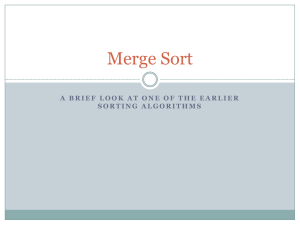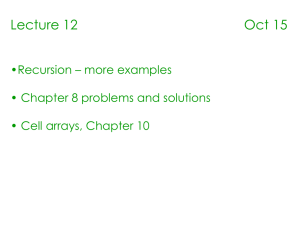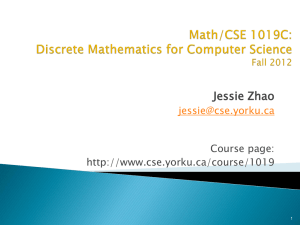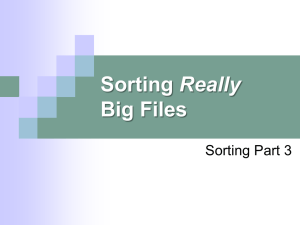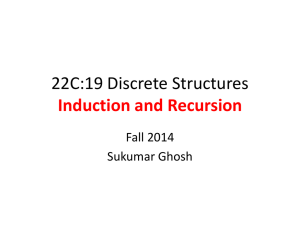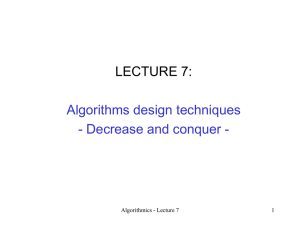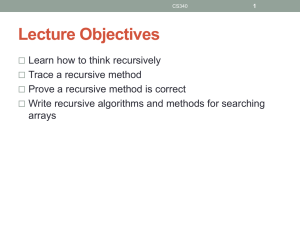Chapter5p3
advertisement
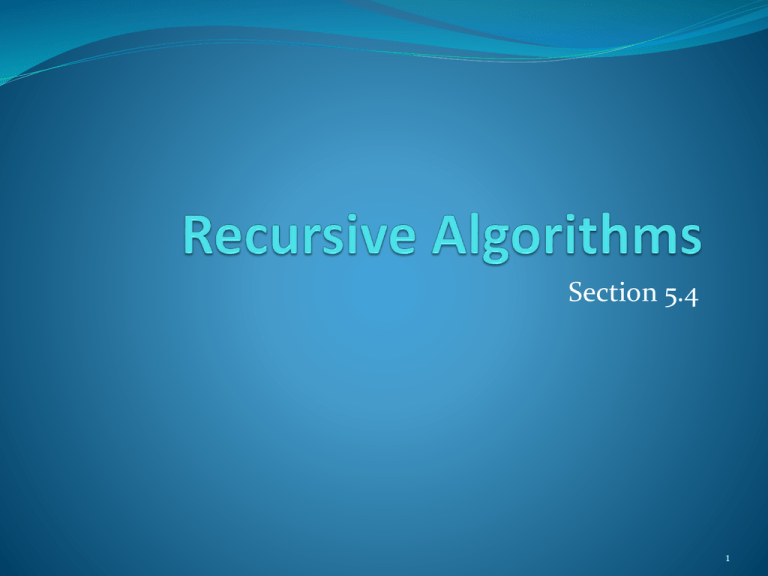
Section 5.4
1
Section Summary
Recursive Algorithms
Proving Recursive Algorithms Correct
Recursion and Iteration (not yet included in overheads)
Merge Sort
2
Recursive Algorithms
Definition: An algorithm is called recursive if it
solves a problem by reducing it to an instance of the
same problem with smaller input.
For the algorithm to terminate, the instance of the
problem must eventually be reduced to some initial
case for which the solution is known.
3
Recursive Factorial Algorithm
Example: Give a recursive algorithm for computing n!,
where n is a nonnegative integer.
Solution: Use the recursive definition of the factorial
function.
procedure factorial(n: nonnegative integer)
if n = 0 then return 1
else return n∙(n − 1)
{output is n!}
Assignment: Implement this algorithm.
4
Recursive Exponentiation Algorithm
Example: Give a recursive algorithm for computing an,
where a is a nonzero real number and n is a
nonnegative integer.
Solution: Use the recursive definition of an.
procedure power(a: nonzero real number, n: nonnegative
integer)
if n = 0 then return 1
else return a∙ power (a, n − 1)
{output is an}
Assignment: Implement this algorithm.
5
Recursive GCD Algorithm
Example: Give a recursive algorithm for computing
the greatest common divisor of two nonnegative
integers a and b with a < b.
Solution: Use the reduction
gcd(a,b) = gcd(b mod a, a)
and the condition gcd(0,b) = b when b > 0.
procedure gcd(a,b: nonnegative integers
with a < b)
if a = 0 then return b
else return gcd (b mod a, a)
{output is gcd(a, b)}
Assignment: Implement
this algorithm.
6
Recursive Modular Exponentiation
Algorithm
Example: Devise a a recursive algorithm for
computing bn mod m, where b, n, and m are
integers with m ≥ 2, n ≥ 0, and 1≤ b ≤ m.
Solution:
(see text for full explanation)
procedure mpower(b,m,n: integers with b > 0 and m ≥ 2, n ≥ 0)
if n = 0 then
Assignment: Implement
return 1
this algorithm.
else if n is even then
return mpower(b,n/2,m)2 mod m
else
return (mpower(b,⌊n/2⌋,m)2 mod m∙ b mod m) mod m
{output is bn mod m}
7
Recursive Binary Search Algorithm
Example: Construct a recursive version of a binary
search algorithm.
Solution: Assume we have a1,a2,…, an, an increasing sequence of
integers. Initially i is 1 and j is n. We are searching for x.
procedure binary search(i, j, x : integers, 1≤ i ≤ j ≤n)
m := ⌊(i + j)/2⌋
if x = am then
Assignment: Implement this
return m
algorithm.
else if (x < am and i < m) then
return binary search(i,m−1,x)
else if (x > am and j >m) then
return binary search(m+1,j,x)
else return 0
{output is location of x in a1, a2,…,an if it appears, otherwise 0}
8
Proving Recursive Algorithms Correct
Both mathematical and str0ng induction are useful techniques to show that recursive
algorithms always produce the correct output.
Example: Prove that the algorithm for computing the powers of real numbers is correct.
procedure power(a: nonzero real number, n: nonnegative integer)
if n = 0 then return 1
else return a∙ power (a, n − 1)
{output is an}
Solution: Use mathematical induction on the exponent n.
BASIS STEP: a0 =1 for every nonzero real number a, and power(a,0) = 1.
INDUCTIVE STEP: The inductive hypothesis is that power(a,k) = ak, for all
a ≠0.
Assuming the inductive hypothesis, the algorithm correctly computes ak+1, since
9
.
−
2
power(a,k + 1) = a∙ power (a, k) = a∙ ak = ak+1 .
Merge Sort
Merge Sort works by iteratively splitting a list (with an
even number of elements) into two sublists of equal
length until each sublist has one element.
Each sublist is represented by a balanced binary tree.
At each step a pair of sublists is successively merged
into a list with the elements in increasing order. The
process ends when all the sublists have been merged.
The succession of merged lists is represented by a
binary tree.
10
Merge Sort
Example: Use merge sort to put the list
8,2,4,6,9,7,10, 1, 5, 3
into increasing order.
Solution:
11
Recursive Merge Sort
Example: Construct a recursive merge sort algorithm.
Solution: Begin with the list of n elements L.
procedure mergesort(L = a1, a2,…,an )
if n > 1 then
Assignment: Implement this
m := ⌊n/2⌋
algorithm.
L1 := a1, a2,…,am
L2 := am+1, am+2,…,an
L := merge(mergesort(L1), mergesort(L2 ))
{L is now sorted into elements in increasing order}
continued →
12
Recursive Merge Sort
Subroutine merge, which merges two sorted lists.
procedure merge(L1, L2 :sorted lists)
L := empty list
while L1 and L2 are both nonempty
remove smaller of first elements of L1 and L2 from its list;
put at the right end of L
if this removal makes one list empty
then remove all elements from the other list and append them to L
return L {L is the merged list with the elements in increasing order}
Complexity of Merge: Two sorted lists with m
elements and n elements can be merged into a sorted
list using no more than m + n − 1 comparisons.
13
Merging Two Lists
Example: Merge the two lists 2,3,5,6 and 1,4.
Solution:
14
Complexity of Merge Sort
Complexity of Merge Sort: The number of comparisons
needed to merge a list with n elements is O(n log n).
For simplicity, assume that n is a power of 2, say 2m.
At the end of the splitting process, we have a binary tree with m
levels, and 2m lists with one element at level m.
The merging process begins at level m with the pairs of 2m lists
with one element combined into 2m−1 lists of two elements. Each
merger takes two one comparison.
The procedure continues , at each level (k = m, m−1,
m−1,…,3,2,1) 2k lists with 2m−k elements are merged into 2k−1
lists, with 2m−k + 1 elements at level k−1.
We know (by the complexity of the merge subroutine) that each
merger takes at most 2m−k + 2m−k − 1 = 2m−k+ 1 − 1 comparisons.
continued →
15
Complexity of Merge Sort
Summing over the number of comparisons at each level,
shows that
because m = log n and n = 2m.
(The expression
in the formula above is
evaluated as 2m − 1 using the formula for the sum of the
terms of a geometric progression, from Section 2.4.)
In Chapter 11, we’ll see that the fastest comparison-based
sorting algorithms have O(n log n) time complexity. So,
merge sort achieves the best possible big-O estimate of
time complexity.
16
